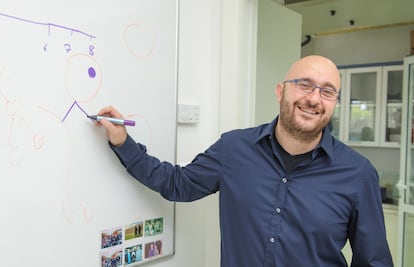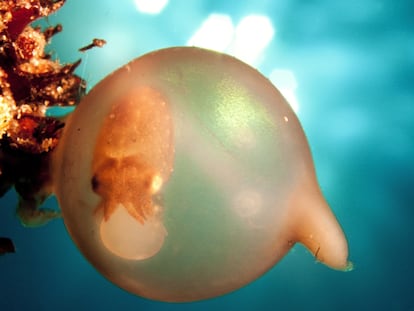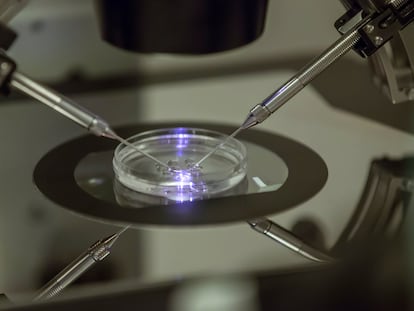New 14-day embryo model sheds light on the biggest enigma of human development
Palestinian scientist Jacob Hanna uses a chemical cocktail to induce self-organization of embryonic stem cells into a structure similar to a natural embryo
The developmental biologist Lewis Wolpert left behind a famous dictum: ‘It is not birth, marriage or death, but gastrulation which is truly the most important time in your life.’ Precisely 14 days after a sperm and egg unite, the embryo, a tiny sphere of a few hundred cells, will begin gastrulation, a week-long process in which that little ball will become the first sketch of an individual. Those days are the greatest enigma in the formation of a human being, because of the technical and ethical barriers to investigating them. Palestinian scientist Jacob Hanna, one of the world leaders in this field, has succeeded in creating a new model of human embryo, obtained from stem cells, which mimics the three-dimensional architecture of a natural embryo between seven and 14 days old, according to his preliminary results, to which EL PAÍS has had access. “This is the first time that synthetic human embryos have been obtained without genetic modification,” says Hanna, of the Weizmann Institute of Science in Rehovot, Israel. The draft of his study will be published Thursday in bioRxiv, a repository for unreviewed biology preprints.
The cells of an embryo that’s just a few days old are pluripotent: they can be transformed into any cell of an adult person, whether of the heart, lung or brain. These all-powerful cells can also be extracted and cultured individually in the laboratory. They will divide and create identical copies of themselves for an indefinite period of time. Jacob Hanna’s group uses a chemical cocktail to induce self-organization of embryonic stem cells into a human embryo-like structure.
Hanna’s results come in the midst of an international controversy. The Anglo-Polish biologist Magdalena Żernicka-Goetz, a researcher at the University of Cambridge, announced Wednesday at a conference in Boston that her team has created a similar human embryo model, capable of developing in the laboratory to a stage equivalent to 14 days, according to an article published on Thursday by the British newspaper The Guardian. Żernicka-Goetz, who does genetically modify cells, has not published the results. Three international experts consulted by EL PAÍS doubted the achievement..

Jacob Hanna himself is very blunt. “This is not serious science and it is very poor journalism. According to what Professor Żernicka-Goetz presented yesterday, these structures do not qualify as an embryoid model, because an embryo should have a placenta, yolk sac, amniotic cavity and chorionic sac, and none of these structures were there. I find their data very unconvincing,” he says. “Scientists working with stem cells should try not to do the same as [Chinese scientist] He Jiankui, who announced CRISPR babies [the first genetically engineered humans] without publishing any data to back it up,” he adds.This newspaper has requested further information from Żernicka-Goetz, without obtaining a response.
French engineer Nicolas Rivron already used embryonic stem cells in 2021 to create models of human blastocysts - embryos of about five days and about 200 cells - at the Institute of Molecular Biotechnology in Vienna. In some countries, such as Australia, these pseudo-embryos are treated as real embryos and are regulated by the same strict legislation. Nicolas is also sceptical about Magdalena Zernicka-Goetz’s results. “I am not very convinced this is recapitulating human development. As far as I understand, this data is unpublished, the article is under revision, and in competition with others. This looks like an attempt for a priority claim. Of note, this The Guardian article is surprisingly inaccurate and filled with factual mistakes to the point that it is hard to know where to start,” he says.
In April, Chinese neuroscientist Zhen Liu’s team at the Shanghai Neuroscience Institute succeeded in generating macaque pseudoembryos in the laboratory and implanting them in the uterus of three monkeys, initiating three pregnancies, but all of them failed after a few days. For the scientific community, if they cannot develop in the maternal womb, they are not real embryos, but simple embryo models.
In 2020 a team led by Spanish biologist Alfonso Martínez Arias achieved, from embryonic cells grown in the laboratory, structures similar to a part of a human embryo of about 19 days, without the brain seed or the tissues that would normally form the placenta. Martínez Arias of Pompeu Fabra University applauds Jacob Hanna’s “impressive” results. However, he also criticizes Magdalena Żernicka-Goetz’s announcement: “There is not much to say because of lack of information. There is no data, because their work has not been published in any format. This field has a bad habit of making big headlines that then don’t match reality. I suspect this is another case.” Competition to be the first is fierce, but in this case Martínez Arias has no doubts about who is ahead. Jacob Hanna, he explains, already presented his results to his colleagues at a congress held in March in Japan.
French biologist Irène Aksoy believes that these embryo models are “a tremendous tool” to shed light on the development of the human being at stages that are inaccessible today, when the development of the different organs begins. Aksoy and her colleague Pierre Savatier have created monkey and human chimeras at the Institute for Stem Cell and Brain Research in Lyon: macaque embryos of about 250 cells, in which 10 of them were human. The biologist stresses the ethical dilemmas, although she emphasizes that in these models there is nothing that resembles a beating heart or an incipient brain, since the development of the structures is stopped much earlier. “There are ethical boundaries that need to be raised, as in this case the science has outpaced the law and no one would want to reiterate the CRISPR babies’ fiasco,” she warns.
Sign up for our weekly newsletter to get more English-language news coverage from EL PAÍS USA Edition
Tu suscripción se está usando en otro dispositivo
¿Quieres añadir otro usuario a tu suscripción?
Si continúas leyendo en este dispositivo, no se podrá leer en el otro.
FlechaTu suscripción se está usando en otro dispositivo y solo puedes acceder a EL PAÍS desde un dispositivo a la vez.
Si quieres compartir tu cuenta, cambia tu suscripción a la modalidad Premium, así podrás añadir otro usuario. Cada uno accederá con su propia cuenta de email, lo que os permitirá personalizar vuestra experiencia en EL PAÍS.
¿Tienes una suscripción de empresa? Accede aquí para contratar más cuentas.
En el caso de no saber quién está usando tu cuenta, te recomendamos cambiar tu contraseña aquí.
Si decides continuar compartiendo tu cuenta, este mensaje se mostrará en tu dispositivo y en el de la otra persona que está usando tu cuenta de forma indefinida, afectando a tu experiencia de lectura. Puedes consultar aquí los términos y condiciones de la suscripción digital.
More information
Archived In
Últimas noticias
Most viewed
- Reinhard Genzel, Nobel laureate in physics: ‘One-minute videos will never give you the truth’
- Oona Chaplin: ‘I told James Cameron that I was living in a treehouse and starting a permaculture project with a friend’
- Pablo Escobar’s hippos: A serious environmental problem, 40 years on
- Charles Dubouloz, mountaineering star, retires at 36 with a farewell tour inspired by Walter Bonatti
- Why we lost the habit of sleeping in two segments and how that changed our sense of time











































